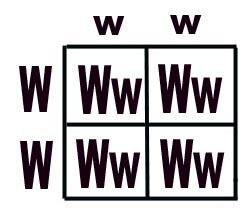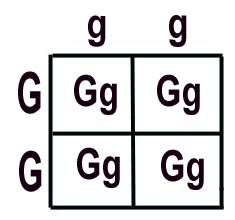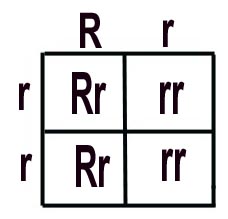Mr kousen is … ![]() Water Man.
Water Man.
Mr kousen is … ![]() Water Man.
Water Man.
Hello. On this page is a set of "typical" genetics questions that are best answered using a punnett square. It would be handy for you to have a pencil & some paper to work out the problems, & then you can click to see an explained solution to each.For those who would benefit from a step-by-step explaination of how to use a p-square, click the link below to my "Baby Steps through the Punnet Square" page.
As always, do your best!
P-squARe prActICE QueSTioN #1
Let's say that in seals, the gene for the length of the whiskers has two alleles. The dominant allele (W) codes long whiskers & the recessive allele (w) codes for short whiskers.
a) What percentage
of offspring would be expected to have short whiskers from the cross of
two long-whiskered seals, one that is homozygous dominant and one that
is heterozygous?
b) If one parent
seal is pure long-whiskered and the other is short-whiskered, what percent
of offspring would have short whiskers?
P-sqARE PraCTice qUesTiON #2
In purple people eaters, one-horn is dominant and no horns is recessive. Draw a Punnet Square showing the cross of a purple people eater that is hybrid for horns with a purple people eater that does not have horns. Summarize the genotypes & phenotypes of the possible offspring.
p-sqUaRe pRAcTicE QUestiON #3
A green-leafed luboplant (I made this plant up) is crossed with a luboplant with yellow-striped leaves. The cross produces 185 green-leafed luboplants. Summarize the genotypes & phenotypes of the offspring that would be produced by crossing two of the green-leafed luboplants obtained from the initial parent plants.
P-squARE PRacTice qUeStION #4
Mendel found that crossing wrinkle-seeded plants with pure round-seeded plants produced only round-seeded plants. What genotypic & phenotypic ratios can be expected from a cross of a wrinkle-seeded plant & a plant heterozygous for this trait (seed appearance)?
NOTES:
Seem like too much to memorize? Maybe it is. But the thing is if you can use the Punnett Square, you can work out ANY problem & get reliable results, so memorizing that chart ISN"T necessary. |
|
|
using the Punnett Square. Back to the Baby Steps Page. |
 |
In seals, the gene for the length of the whiskers has two alleles. The dominant allele (W) codes long whiskers & the recessive allele (w) codes for short whiskers.
a) What percentage of offspring would be expected to have short whiskers from the cross of two long-whiskered seals, one that is homozygous dominant and one that is heterozygous? ANSWER: 0%.
I
personally like to write down the info given in the question on my paper
first. So I start by writing:
W
= allele for long whiskers
w
= allele for short whiskers
A
homozygous dominant seal would be "WW" (homozygous dominant = 2 CAPITAL
letters).
A
heterozygous seal would be "Ww" (heterozygous = 1 CAPITAL & 1 lowercase).
The
cross is in the question therefore: WW x Ww.
The
P-Square would look like this:

The
possible gametes from the homozygous parent seal are on the left in front
of the rows, & the possible gametes from the heterozygous parent are
above the columns. We fill in the boxes by copying "one letter from the
left, one letter from the top".
Analyzing our results, we find that 50% of our offspring (2 of 4 boxes) are "WW", and 50% (2 of 4 boxes) are "Ww". In terms of phenotype (what they would look like) 100% would have long whiskers (because all of the offspring have at least one "W", which codes for long whiskers).
So the answer to question 1a is: 0% would have short whiskers. The only way to have short whiskers is to be "ww", and that combo is not possible from the parents in this cross.
b) If one parent seal is pure long-whiskered and the other is short-whiskered, what percent of offspring would have short whiskers? ANSWER: 0%.
Again,
I suggest starting by defining symbols like so:
W
= allele for long whiskers
w
= allele for short whiskers
"Pure"
is the same as homozygous, so "pure long-whiskered" would be "WW".
If
you're a seal, the only way to have short whiskers is to have the homozygous
recessive genotype, in other words be "ww".
So
our cross is: WW x ww.
The
trusty p-square would be:

The
alleles from the long-whiskered parent (WW) are out in front of the rows
(at the left), & the alleles of the short-whiskered parent are above
the columns. By the way, we could switch that around & it would
not change our answer at all. What I'm saying is: it doesn't matter
where you put the parents (top or side).
Anyway,
all our offspring (4 of 4 boxes) have the same genotype: "Ww" & would
all end up with long whiskers. To summarize the offspring:
genotype
= 100% heterozygous (Ww)
phenotype
= 100% long-whiskered.
So
our answer to Question 1b is also: 0% would be short-whiskered.
|
In any cross involving at least one parent that is homozygous dominant (2 CAPITAL letters), 100% of the offspring will have the dominant trait in their phenotype. This is illustrated by Questions 1a & 1b. |
In purple people
eaters, one-horn is dominant and no horns is recessive. Draw a Punnet Square
showing the cross of a purple people eater that is hybrid for horns with
a purple people eater that does not have horns. Summarize the genotypes
& phenotypes of the possible offspring.
ANSWER:
|
|
|
|
50% homozygous recessive (hh) |
50% no horns |
No
specific letter is given in the question to use as an abbreviation, so
it's UP TO YOU! Being a real rebel, I'll use this:
H
= dominant allele for one horn
h
= recessive allele for no (zero) horns
A
purple people eater that is "hybrid" has one of each letters (the definition
of hybrid), so that parent is "Hh". A purple people eater without horns
has the recessive phenotype and the only way to have a recessive phenotype
is to have a homozygous recessive genotype, which is 2 lowercase letters,
"hh".
So
our cross for this question is: Hh x hh.
The
p-square should be:

Alright,
there we have it. The alleles carried in the sex cells of the purple
people eaters are split up & placed "outside" the p-square. The
alleles from the one-horn eater are on the left, and the alleles of the
eater without horns are above each column. Copy one letter from the left
& one from the top to fill-in the boxes. The combinations inside
the boxses are the possible genotypes (with respect to horns) of purple
people eater offspring from these two parent purple people eaters.
Analyzing
the data is simple count how many of each genotype & phenotype are
found in each of the four boxes. So, here we have 2 of 4 boxes "Hh"
(50% hybrid, one horn), and 2 of 4 boxes "hh" (homozygous recessive, no
horns).
Is
you confidence soaring?
| Note: As far as I know, purple people eaters do not exist. They are ficticious creatures. |
A green-leafed luboplant
(I made this plant up) is crossed with a luboplant
with yellow-striped leaves. The cross produces 185 green-leafed luboplants.
Summarize the genotypes & phenotype of the offspring that would be
produced by crossing two of the green-leafed luboplants obtained from the
initial parent plants.
ANSWER:
|
|
|
|
50% hybrid (Gg) 25% homozygous recessive (gg) |
25% yellow-striped leaves |
OK,
first let's jot down some letters & what they stand for. Since the
parent luboplants have different leaf colors and 100% of the offspring
resemble only one parent (i.e. they are all green), green is the dominant
trait. It makes sense then to use:
G
= dominant allele for green leaves
g
= recesssive allele for yellow-striped leaves
| TIP: This is important
to recognize -
and all their offspring look like only one of the parents, the trait the offspring have is the DOMINANT TRAIT. |
The
185 "F1" offspring are all hybrids. How do I know? Lots of practice. The
yellow-striped parent MUST BE "gg". The 185 offspring had to have inherited
a "g" from that parent plant because that parent plant has no "G's" to
pass on. Since the 185 offspring are ALL green, they must have a dominant
allele for green ("G"), so their entire genotype is "Gg".
Don't
believe me? That first cross must have been GG x gg, & its p-square
would look like this:

Notice
that 100% are hybrid (Gg) and 100% would look green. IF that green
parent had "Gg" for a genotype, then we would get half of the offspring
with a homozygous recessive genotype (gg), which would give us 50% yellow-striped
luboplants. THIS IS NOT WHAT HAPPENED. The questions clearly states
that all fo the 185 plants are green, pretty good evidence that green-leafed
parent luboplant is "GG" & not "Gg".
The
offspring of this cross, by the way, are refferred to as the "first filial"
or "F1" generation.
Now,
our question has to do with crossing two memebers of this F1 generation.
That cross would be: Gg x Gg.
The
punnett square showing this cross of two hybrids is:

Summary of results:<--BACK TO QUESTION 3
Genotypes of the F2 Offspring Phenotype(s) of F2 Offspring 1 of 4 boxes (25%) homozygous dominant (GG)
2 of 4 boxes (50%) hybrid (Gg)
1 of 4 boxes (25%) homozygous recessive (gg)3 of 4 boxes (75%) green-leafed
1 of 4 boxes (25%) yellow-striped leaves
Mendel found that
crossing wrinkle-seeded plants with pure round-seeded plants produced only
round-seeded plants. What genotypic & phenotypic ratios can be
expected from a cross of a wrinkle-seeded plant & a plant heterozygous
for this trait?
ANSWER: 50% HYBRID
ROUND-SEEDED, & 50% HOMOZYGOUS RECESSIVE WRINKLE-SEEDED
The
first thing to figure out is which trait is dominant & which is recessive.
We get this from the 1st sentence. If a wrinkled x round cross produces
all round, then round is dominant & wrinkled is recessive.
Define
our symbols:
R
= dominant allele for round seeds
r
= recessive allele for wrinkled seeds
Our
wrinkle-seeded parent MUST be "rr", because the only way for a recessive
trait to show up is if the genotype is homozygous recessive, which is 2
lowercase letters (rr). Our parent that is "heterozygous for this
trait" is "Rr", because heterozygous = hybrid= 1 CAPITAL & 1 lowercase.
So
our cross for this problem is: rr x Rr.
The
p-square you drew should look something like this:

Again,
you may have your "r's" on top & the "R" & "r" on the left, the
combos inside the p-square will end up the same. No problem. Remember,
"one from the left & one from the top" when you are filling in the
boxes. Of the offspring in this cross, 2 of 4 (50%) are hybrid (Rr) and
would have round seeds, and 2 of 4 (50%) are homozygous recessive (rr)
and would have wrinkled seeds.
Good
work.
<--BACK
TO QUESTION 4
on
to a few little NOTES --->